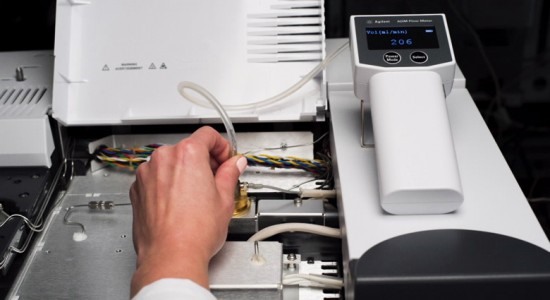A fundamental step towards reliable and repeatable gas chromatography (GC) and creating a robust GC method is to achieve consistent gas flow over time and across diverse laboratories. The flow meter provides researchers an external reference for verifying flows when setting up an instrument and developing a method. It is an integral part of gas chromatography. With todays modern GCs, chromatographers may rely on electronic pressure control (EPC) for setting flow rates. However, many older GCs, that are still in use, do not have an EPC, requiring that flows be set manually using a flow meter.
A tool for troubleshooting
Gas flow meter measurements ensure peace of mind in any GC laboratory. Besides verifying flow rates and minimizing the risk of volumetric drift, a flow meter is an essential tool to have when troubleshooting detector problems. Issues with gas flow can appear in a few ways, and it can be difficult to determine the location of the problem without a flow meter. The appearances of shifting peaks or a noisy baseline are both indications of a disturbance in carrier gas flow. By using the new ADM Flow Meter, the researcher can pin point the location of the problem faster.
Gas flow meter measurements generally fall into two categories: volumetric and mass, both of which measure the amount of gas exiting a column or split vent in a specific time period.
Introducing the ADM Flow Meter
The new and improved Agilent ADM Flow Meter is a value-priced solution that helps meet the needs of all GC labs. As with previous flow meters, the ADM Flow Meter has been developed to measure the volumetric flow rate of noncorrosive gases. As a result, the user does not need to select a gas type. Current models on the market have to be sent off site to a third party to be calibrated annually. The ADM Flow Meter has an innovative easy swappable calibration cartridge that can be replaced by the researcher once a year to keep the meter NIST compliant.
Types of flow
The ADM Flow Meter provides two different types of gas flow meter measurement: volumetric flow (mL/min) and mass flow reported in standard cubic centimeters per minute (sccm). Mass flow values are calculated from the volumetric measurements by correcting for ambient temperature and atmospheric pressure. The values report the flow rate referenced to 0 °C and one atmosphere of pressure.
Volumetric flow mode
The default mode on power-up. In this mode, the volumetric flow rate is displayed in mL/min.
Mass flow mode
In this mode, the volumetric flow rate is corrected to account for the current atmospheric pressure and ambient temperature. The flow rate is displayed in sccm (standard cubic centimeters per minute).
Split mode
In this mode, you can store a flow measurement as a reference value. You can then compare subsequent flow values as a ratio of the current to the reference measurement, which is useful when troubleshooting a GC Inlet.
Storing flow measurements
When in the volumetric flow mode or mass flow mode, up to four flow values can be stored on the screen for reference later.
Simplifying calibration
Usually, chromatographers use third party vendors to recalibrate a flow meter. It requires filling out detailed paperwork, and a drawn out process of awaiting a shipping container, returning the meter and waiting weeks for recalibration. If any damage to the valve or speaker is found, the user is often liable for additional costs for repair.
The new Agilent ADM Flow Meter comes with a cartridge calibrated to NIST standards, which the researcher can replace by themselves within seconds. The benefits include:
- Reduced downtime by not sending away the meter for recalibration or repair
- No geographic or shipping restrictions
- No time-consuming paperwork
A built-in calibration timer automatically warns the researcher when the calibration cartridge needs replacing. It minimizes the risk of volumetric measurement drift and allows the researcher to plan for when they need to order a new calibration cartridge.The ADM Flow Meter has a USB port, enabling downloads of new features and capabilities as well as firmware upgrades as they become available. As a result, the flow meter can always be kept up to date.
Real time monitoring
The ADM Flow Meter can communicate with a PC via its USB port. Data is collected by connecting the USB port to the computer with a USB cable.
Even when accurately calibrated, bubble meters typically read slightly higher than the ADM Flow Meter. The higher reading is due to the relatively high concentrations of water vapor present in the soap bubble apparatus. This property is amplified by the effect of temperature. As the temperatures get warmer, the amount of water vapor increases and the readings can be much higher than the true flow rate. The ADM Flow Meter therefore provides much more accurate results than bubble meters.
For any gas chromatograph, an external reference for verifying flows and a tool for troubleshooting detector problems is always needed. The ADM Flow Meter, with its innovative design that helps maintain it to NIST standards, has everything that is essential to address those needs.
See: The software tool for the ADM Flow Meter
For more information and to view a video for the ADM Flow Meter, click here.
Keywords; Gas Chromatograph; ADM flow meter: recalibrate


-

Dr. Know
-
Cancel
-
Vote Up
0
Vote Down
-
-
Sign in to reply
-
More
-
Cancel
Comment-

Dr. Know
-
Cancel
-
Vote Up
0
Vote Down
-
-
Sign in to reply
-
More
-
Cancel
Children